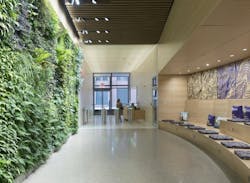Perkins Eastman, Kliment Halsband Architects to merge
By Perkins Eastman
Perkins Eastman and Kliment Halsband Architects are pleased to announce their merger, which will combine the formidable talents, experience, and skills of both legacy firms. With Perkins Eastman celebrating its 40th anniversary and Kliment Halsband celebrating its 50th, this merger promises to create powerful synergies.
Perkins Eastman, the seventh largest architecture and design firm in the world with more than 1,100 employees, has worked on projects on five continents in 60 countries. Its portfolio reflects expertise in multiple practice areas with strengths in healthcare, senior living, large-scale mixed-use, K-12, higher education, hospitality, and workplace design as well as planning, urban design, and strategic consulting. Kliment Halsband Architects is known for designing award-winning new buildings, renovations, and adaptive reuse projects for educational, cultural, and civic institutions. The firm’s reputation for a sensitive, tailored approach for mission-focused clients is long established.
The merger provides a framework for combining Perkins Eastman’s expansive scale, deep reserve of design, and diverse portfolio with Kliment Halsband Architects’ renowned engagement in institutional design, its reputation for pragmatic innovation, and its leadership position within the industry. Both firms have highly collaborative working styles, prioritize client service, and are committed to educating and inspiring the next generation of professionals.
“Both firms believe in the power of design to improve people’s lives, and we’re looking forward to providing that benefit to a wider range of institutions,” says Mary-Jean Eastman, FAIA, co-founder and vice chair of Perkins Eastman.
Frances Halsband, FAIA, a founding partner of Kliment Halsband, adds, “We see things the same way, but we work in different ways to bring something new to the table. When we work together, we accomplish more than when we work individually.” Kliment Halsband will be known as “Kliment Halsband Architects—A Perkins Eastman Studio,” joining Perkins Eastman’s leaders in the K-12 and Colleges and Universities practices. The firms’ New York studios are co-located at 115 Fifth Avenue, New York, NY.
ABOUT PERKINS EASTMAN
Perkins Eastman is a global design firm founded on the belief that design can have a direct and positive impact on people’s lives. The firm’s award-winning practice draws on its 1,100+ professionals networked across 24 studios worldwide. By keeping the user’s needs foremost in the design process, the firm enhances the human experience across the spectrum of the built environment. For more information, visit www.perkinseastman.com.
ABOUT KLIMENT HALSBAND ARCHITECTS—A PERKINS EASTMAN STUDIO
Kliment Halsband Architects, founded by Robert M. Kliment and Frances Halsband in New York City in 1972, is a diverse group of architects committed to the idea that good architecture imparts dignity to organizational mission and individual endeavor. The firm transforms buildings and sites with a measured approach that engages the past and welcomes the future. KHA advocates for sustainability and accessibility for all, but values most a project’s enduring usefulness: beauty, intelligibility to the people who use it, and the ability to adapt to change. The firm has received the AIA Firm Award, the AIA New York City Medal of Honor, and more than 150 awards for design excellence. For more information, visit www.kliment-halsband.com.
